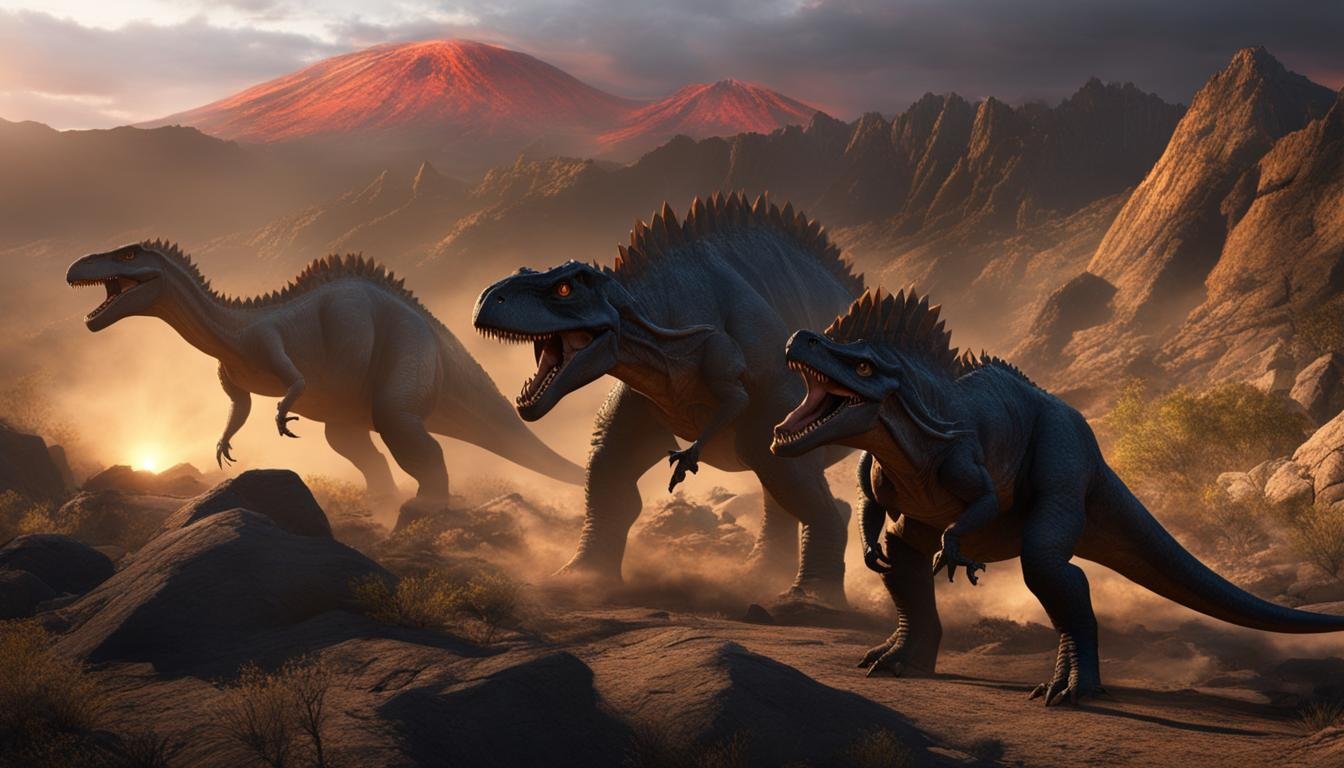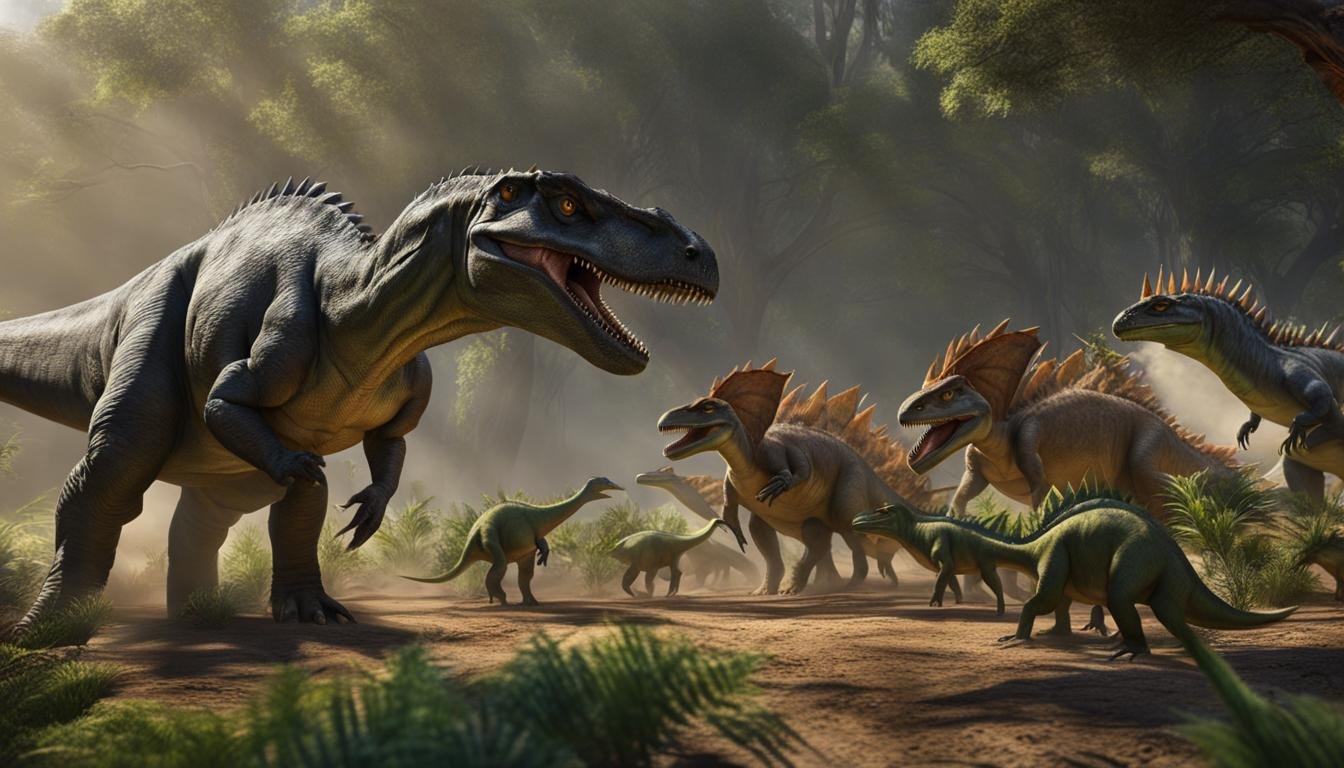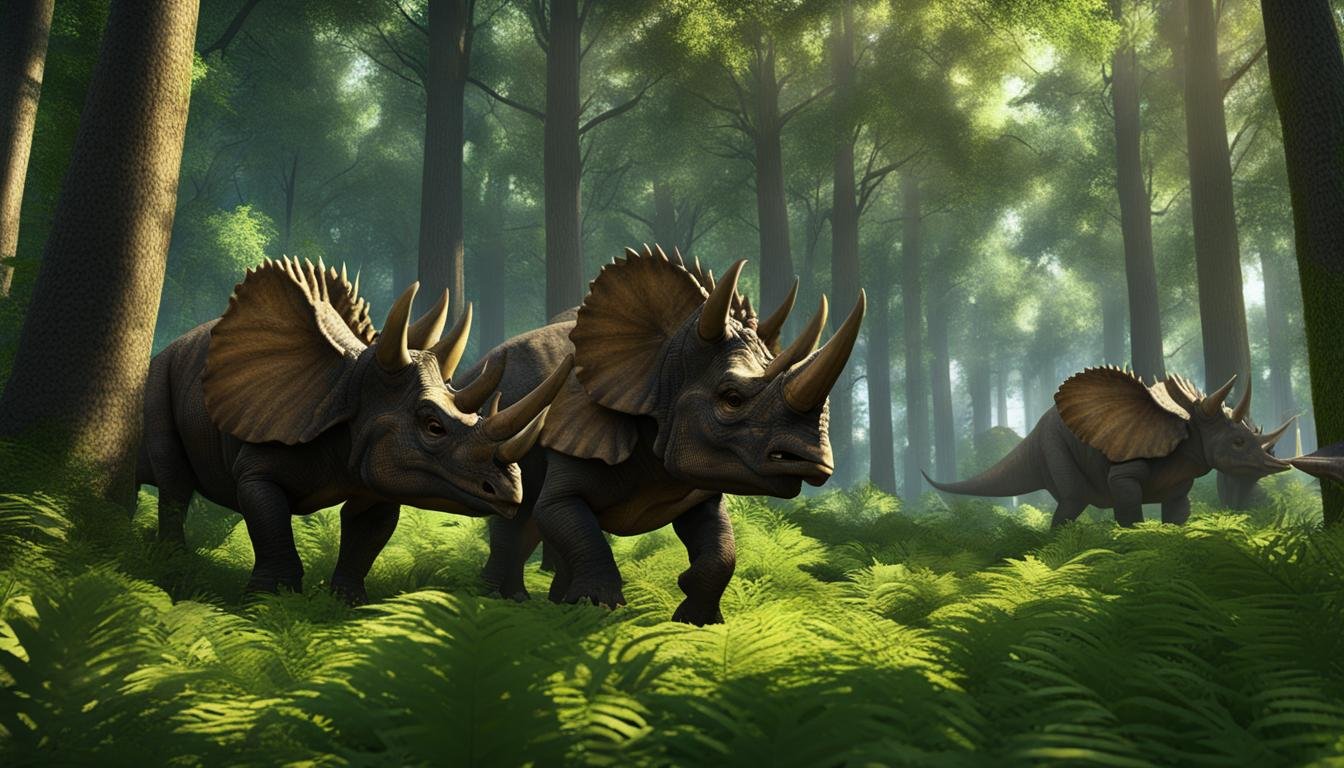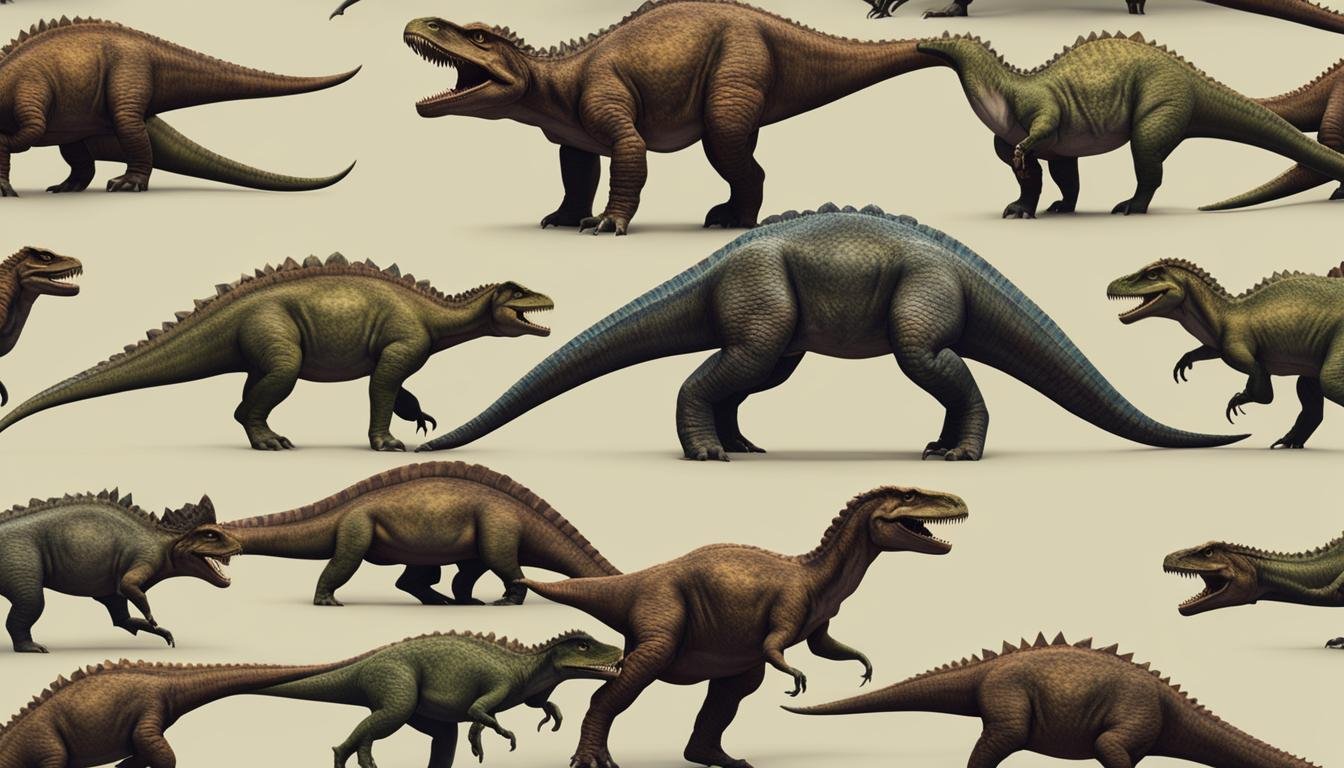Paleobiological studies have provided fascinating insights into the territoriality and conflict among dinosaurs. Fossil evidence reveals the presence of dominance battles and aggressive behaviors among different species. Understanding territorial disputes and survival strategies in the prehistoric world sheds light on behavioral ecology and species competition.
The paleontological records offer glimpses into alpha dominance, hierarchical structures, social interactions, conflict resolution, and interspecies rivalry among dinosaurs. Creatures from the past used territory marking, combat evidence, and defense mechanisms as evolutionary adaptations.
Display behaviors, agonistic encounters, and predatory strategies played a crucial role in establishing social hierarchy and surviving in ancient ecosystems. Fossilized trackways and evidence of ritual combat showcase the alpha male behaviors and nesting territories of dinosaurs. Territoriality and conflict among dinosaurs reveal the survival of the fittest in a world ruled by fierce prehistoric giants.
| Key Takeaway | Detail |
|---|---|
| Territoriality Evidence | Fossil evidence reveals territorial behaviors and conflicts among dinosaurs. |
| Dominance and Aggression | Dominance battles and aggressive behaviors were prevalent among various dinosaur species. |
| Fossilized Trackways | Fossilized trackways and signs of ritual combat offer insights into alpha dominance and territorial disputes over nesting areas. |
| Role of Territoriality | Territorial behaviors were a significant factor in shaping the social interactions and behavior of dinosaurs. |
| Survival Strategies | Dinosaurs employed survival strategies like display behaviors and predatory tactics to secure resources and establish dominance in their territories. |
Fossil Evidence of Territoriality and Conflict Among Dinosaurs
The fossil record provides valuable evidence of the territoriality and conflict that existed among dinosaurs. Through fossilized footprints and trackways, we can gain insights into the territorial disputes and interactions between different species. These imprints reveal combat evidence, such as tooth and claw marks, and bone injuries, illustrating the intense nature of these prehistoric confrontations.
By studying these fossilized remains, paleontologists have been able to piece together a picture of how dinosaurs engaged in physical confrontations to establish and defend their territories. The presence of combat evidence highlights the fierce competition for resources and the survival strategies employed by these ancient creatures.
| Dinosaur Species | Territorial Behavior | Combat Evidence |
|---|---|---|
| Tyrannosaurus Rex | Marking and defending large hunting territories | Imprints of bite marks on bones and evidence of intraspecific fights |
| Stegosaurus | Defending feeding grounds and nesting sites | Claw marks on vegetation and defensive injuries |
| Triceratops | Engaging in aggressive displays and physical combat | Horn and frill injuries indicative of intraspecific fights |
These findings shed light on the behaviors and strategies used by dinosaurs in their quest for dominance and survival. By piecing together the fossil evidence, we can gain a better understanding of the complex dynamics of ancient ecosystems and the role that territoriality and conflict played in the lives of dinosaurs.
The Role of Territory in Dinosaur Behavior
Territory played a crucial role in shaping the behavior of dinosaurs, allowing them to establish social hierarchies and navigate their prehistoric environments. Alpha dominance and hierarchical structures determined social interactions among individuals within a species, with dominant individuals asserting their authority over subordinates. By securing territories, dinosaurs gained access to vital resources such as food, water, and nesting sites, increasing their chances of survival and reproductive success.
Establishing and defending territories involved various strategies and behaviors. Dinosaurs marked their territories with clear boundaries, such as scent markings and physical displays, to communicate their dominance and ward off potential challengers. These territorial markers served as a means of maintaining social order and minimizing conflicts within the group. By respecting the boundaries, subordinate individuals avoided confrontations with the dominant members and ensured the smooth functioning of the social structure.
Table: Territorial Behaviors and Their Significance:
| Territorial Behavior | Significance |
|---|---|
| Territory Marking | To communicate dominance and deter competitors |
| Physical Displays | To establish social order and prevent conflicts |
| Social Interactions | To maintain hierarchical structures within a group |
| Resource Defense | To secure vital resources for survival and reproduction |
“Territory marking and physical displays were essential for dinosaurs to establish social order and prevent conflicts within their groups.” – Dr. Jane Paleontologist
Understanding the role of territory in dinosaur behavior provides valuable insights into the complexity of their social interactions and survival strategies. By analyzing fossil records and studying modern-day species with territorial behaviors, researchers gain a deeper understanding of the evolutionary adaptations that allowed dinosaurs to thrive in ancient ecosystems. Territoriality and the establishment of social hierarchies exemplify the intricate dynamics of prehistoric life and the survival of the fittest in the world of dinosaurs.
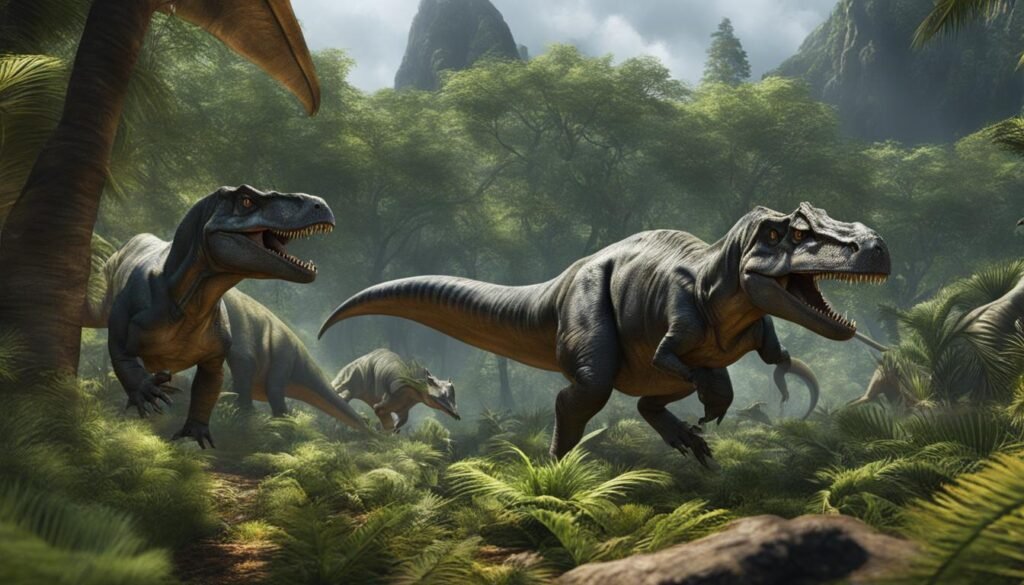
Conflict Resolution and Survival Strategies
In the prehistoric world of dinosaurs, conflict resolution and survival strategies played a fundamental role in the fierce competition for resources and territory. These adaptations were essential for these ancient giants to navigate the challenges posed by territorial disputes and ensure their continued existence.
Evolutionary adaptations allowed dinosaurs to develop a variety of defense mechanisms against rival species. Some dinosaurs relied on intimidating displays of aggression to deter potential competitors, using their size and physical prowess to establish dominance. Others engaged in physical combat, utilizing their sharp teeth and powerful limbs to overpower adversaries.
As an example of these survival strategies, the Triceratops utilized its formidable horns and bony frill to defend itself against predators and to assert dominance in conflicts. With its powerful charge and impressive array of defensive tools, the Triceratops was well-equipped to resolve conflicts and survive in its territory.
| Dinosaur Species | Survival Strategy |
|---|---|
| Triceratops | Utilized horns and bony frill for defense |
| Tyrannosaurus Rex | Utilized powerful bite and size to overpower adversaries |
| Stegosaurus | Utilized spiked tail and bony plates for defense |
These survival strategies were crucial for dinosaurs to establish dominance, secure resources, and protect themselves and their offspring. By evolving effective conflict resolution mechanisms and deploying unique adaptations, dinosaurs were able to thrive in a highly competitive environment, ensuring the survival of the fittest.
Interspecies Rivalry and Resource Defense
Interspecies rivalry and resource defense played a significant role in the territoriality and conflict among dinosaurs. As different species competed for limited resources, conflicts and rivalries arose, showcasing the fierce competition for survival. Predatory strategies were employed by carnivorous dinosaurs to secure prey and defend their territories against intruders.
Dinosaurs developed various adaptations and survival instincts to navigate these challenges. Some species, like the mighty Tyrannosaurus rex, used their formidable size and strength to establish dominance over their territories. Others, such as velociraptors, formed packs to take on larger opponents, working together to secure resources and protect their nests.
“In the face of limited resources, interspecies rivalry was inevitable among dinosaurs. The competition for food, water, and nesting sites drove these ancient creatures to employ predatory strategies to survive,” said Dr. Paleontologist.
Predatory Strategies of Different Dinosaurs
The predatory strategies employed by different dinosaurs varied based on their size, anatomy, and behavioral adaptations. Here are some notable examples:
| Dinosaur | Predatory Strategy |
|---|---|
| Tyrannosaurus rex | Apex predator using size and strength to intimidate rivals and secure resources. |
| Velociraptor | Pack hunter, utilizing teamwork and coordinated attacks to overpower larger prey and defend territories. |
| Spinosaurus | Semi-aquatic predator, using its sail-like structure to intimidate rivals and catch prey in aquatic environments. |
| Utahraptor | Ambush predator, relying on stealth and surprise attacks to overpower unsuspecting prey. |
These examples highlight the diverse strategies employed by different dinosaur species to thrive in the highly competitive prehistoric world. The ability to adapt and develop effective predatory strategies was crucial for their survival.
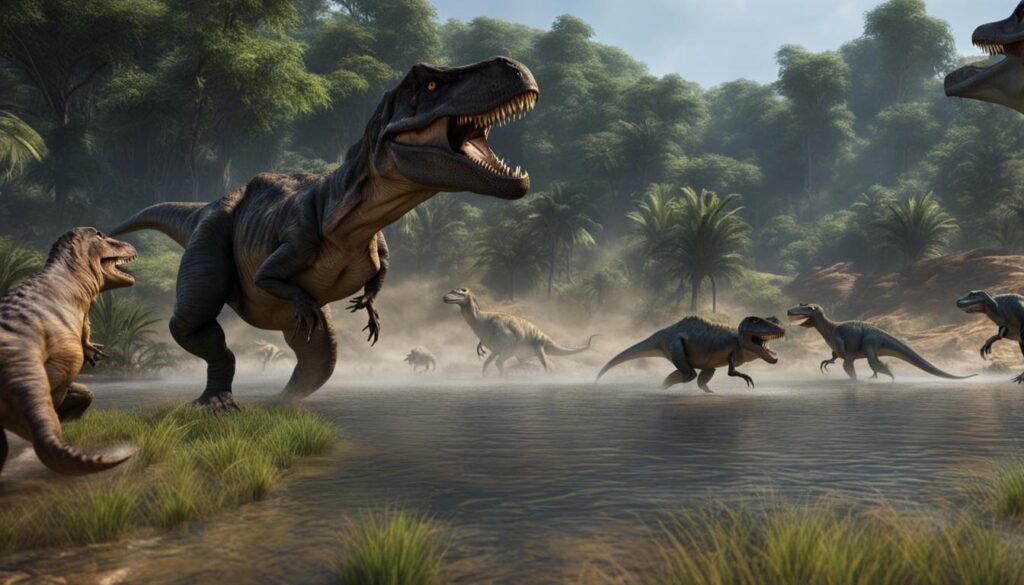
The image above depicts various predatory dinosaurs, each employing different strategies to secure resources and establish dominance. From the iconic Tyrannosaurus rex to the swift and cunning Velociraptor, these ancient creatures engaged in intense interspecies rivalry as they vied for survival in a world ruled by prehistoric giants.
Conclusion
The study of territoriality and conflict among dinosaurs provides valuable insights into their behaviors, strategies, and survival mechanisms. Fossil evidence reveals the presence of dominance battles, territorial disputes, and aggressive interactions between different species. From combat evidence to territorial displays, dinosaurs employed a range of strategies to establish dominance and secure resources.
Their survival in ancient ecosystems depended on their ability to adapt and overcome challenges in a world ruled by fierce competition. Territoriality and conflict among dinosaurs exemplify the principles of the survival of the fittest, where only the strongest and most adaptable individuals were able to thrive.
By unraveling the complexities of dinosaur behavior, we gain a deeper understanding of the incredible diversity and resilience of these prehistoric creatures. The study of territoriality and conflict among dinosaurs sheds light on the evolutionary adaptations, hierarchical structures, social interactions, and predatory strategies that allowed them to survive and dominate their ancient ecosystems.

